Machine Learning for Wireless Sensor Networks Security: An Overview of Challenges and Issues
Abstract
1. Introduction
- We explain in detail the security requirements covered by ML algorithms in WSN security in current applications
- We present a systematic and comprehensive survey of current technologies in the literature related to improving the security of WSNs using machine learning techniques. The pros and cons of each technique are also highlighted.
- We describe the limitations of using ML in current security solutions for WSNs, the challenges open to ML algorithms in providing them with security, and future re-search solutions.
2. Background on WSN
2.1. WSN Overview
- Independent nodes without a central control
- Stationary or mobile WSN nodes
- The transmission range of WSN nodes is also limited
- The WSN network topology is constantly changing
- Multiple hop connections
- Limited bandwidth
2.2. WSN Applications
2.3. Security in WSN
Attacks on WSNs
- Eavesdropping
- 2.
- Jamming
- 3.
- Collision
- 4.
- Unfairness
- 5.
- Exhaustion
- 6.
- Traffic monitoring
- 7.
- Hole attack
- 8.
- Selective forwarding
- 9.
- Sybil
- 10.
- Spoofing
- 11.
- Session hijacking
- 12.
- Repudiation
- 13.
- Deluge
- 14.
- DoS
2.4. Why Is Machine Learning Needed in WSN Security?
3. Machine Learning Techniques
3.1. Supervised Learning
3.1.1. k-Nearest Neighbor
3.1.2. Decision Tree
3.1.3. Random Forest
3.1.4. Supportive Vector Machine
3.1.5. Naïve Bayes
3.1.6. Artificial Neural Network
3.1.7. Logistic Regression
3.1.8. Least-Mean-Square
3.1.9. Bayesian
3.2. Unsupervised Learning
3.2.1. K-Means
3.2.2. Fuzzy Logic
3.3. Deep Learning
3.3.1. Convolutional Neural Networks
3.3.2. Recurrent Neural Networks
3.3.3. Long-Term Short Memory
3.3.4. Multi-Layer Perceptron
3.3.5. Backpropagation Neural Networks
4. WSN Security Challenges
4.1. Challenges of WSN Security
4.1.1. Absence of Centralized Control
4.1.2. WSNs Topology Changes
4.1.3. Scalable Trust Management
4.1.4. Limited Resources
4.2. Challenges of Using ML Algorithms in WSN Security
- Machine learning algorithms, which include learning from historical data, cannot make accurate real-time predictions. The amount of additional data determines the efficiency of the algorithm. When the amount of data is huge, the cost of energy required to process it is equally large. In other words, there is a trade-off between the power limitations of the WSN and the higher computing burden of the ML algorithm. ML algorithms must be implemented centrally to avoid this trade-off. Therefore, these algorithms pose a risk [27] for wireless sensor network environments.
- Machine learning techniques cannot be applied to all WSN’s security requirements. Sometimes it is difficult to apply them to some security domains, such as authentication and integrity [107]. Providing such operations between WSN nodes requires a high CPU and power. This can be represented by authentication between the vehicle and the driver, for example, but it is difficult to represent between one WSN node and another [108]. On the other hand, some studies have used ML algorithms for authentication through physical channel exploits [109]. These ML techniques are discussed in Section 5.2.
- Most machine learning algorithms have a margin of error, even if this margin is small, it is there. Therefore, in secret data, its confidentiality should be close to perfect [110]. The authors worked in [111] by providing a Mathematical Encryption Standard (MES) to increase case-based risk monitoring of confidential healthcare data using ML technology. Decision-making regarding the risk control strategy in MES was enhanced based on a fuzzy inference system integrated with neural networks. Analysis of the results shows that the MES error rate is less than 0.05 and the accuracy rate is 97%, which indicates their desire to increase security risks. Despite the improvements made by the authors, there is still an error rate, even if it is close to zero.
5. Applications of ML to Secure WSN Networks
5.1. Availability
5.1.1. Intrusion Detection
| Refs. | ML Technique | Processing Cost | Advantage | Limitations |
|---|---|---|---|---|
| [114] | Water Cycle + DT | Low |
|
|
| [115] | Various ML algorithms | - |
|
|
| [84] | Various ML algorithms | - |
|
|
| [116] | BLR | low |
|
|
| [117] | Fuzzy logic association rules | medium |
|
|
| [75] | Two levels of SVM | Medium |
|
|
| [30] | DNN | High |
|
|
| [78] | PSO and BNN | High |
|
|
| [118] | PSO, GA, rotation forest, and bagging | High |
|
|
| [119] | SVM + MLP | High |
|
|
| [120] | LTSM + Gaussian Bayes | High |
|
|
| [77] | MLP + GA | High |
|
|
| [122] | SDN + different ML algorithms | Low |
|
|
| [123] | KNN + AOA |
|
| |
| [124] | SDN + naïve Bayes | Low |
|
|
| [125] | SDN + TIER-1 | Low |
|
|
| [126] | SDN + CNN | Low |
|
|
| [127] | SDN + CNN | Low |
|
|
5.1.2. Error Detection
5.1.3. Congestion Control
5.2. Authentication
| Refs. | ML Technique | Processing Cost | Advantage | Accuracy | Limitations |
|---|---|---|---|---|---|
| [141] | LTSM | Moderate | Improved performance accuracy for long-term fault signals | 99.5% |
|
| [21] | Gradient algorithm + DNN | Low | Improved authentication rate through reducing training time | 91% |
|
| [22] | Channel information + ML | Low | Improved authentication rate by using ε-greedy strategy | 99.8% |
|
| [142] | kernel least-mean-square | High | Improved authentication rate by using reducing N-dimensional vector to a single-dimensional vector space | 97.5% |
|
| [143] | Various ML algorithms | Moderate | Improved performance accuracy through tracing WSN node behavior | 96% |
|
| [145] | Various ML algorithms | Moderate | Improved performance accuracy through WSN node history | 97.5% |
|
5.3. ML-Based WSN Diversified Security
6. Discussion and Open Issues
6.1. Location of the ML Training Process
6.2. Lightweight ML Algorithms
6.3. Privacy Concerns
6.4. Trust Domain
7. Conclusions
Author Contributions
Funding
Institutional Review Board Statement
Informed Consent Statement
Data Availability Statement
Conflicts of Interest
References
- Wazirali, R.; Ahmad, R.; Al-Amayreh, A.; Al-Madi, M.; Khalifeh, A. Secure Watermarking Schemes and Their Approaches in the IoT Technology: An Overview. Electronics 2021, 10, 1744. [Google Scholar] [CrossRef]
- Bouaziz, M.; Rachedi, A. A survey on mobility management protocols in Wireless Sensor Networks based on 6LoWPAN technology. Comput. Commun. 2016, 74, 3–15. [Google Scholar] [CrossRef]
- Al-Kashoash, H.A.A.; Kharrufa, H.; Al-Nidawi, Y.; Kemp, A.H. Congestion control in wireless sensor and 6LoWPAN networks: Toward the Internet of Things. Wirel. Networks 2019, 25, 4493–4522. [Google Scholar] [CrossRef]
- Moridi, M.A.; Kawamura, Y.; Sharifzadeh, M.; Chanda, E.K.; Wagner, M.; Okawa, H. Performance analysis of ZigBee network topologies for underground space monitoring and communication systems. Tunn. Undergr. Sp. Technol. 2018, 71, 201–209. [Google Scholar] [CrossRef]
- Ertürk, M.A.; Aydın, M.A.; Büyükakkaşlar, M.T.; Evirgen, H. A Survey on LoRaWAN Architecture, Protocol and Technologies. Futur. Internet 2019, 11, 216. [Google Scholar] [CrossRef]
- Kumar, V.; Tiwari, S. Routing in IPv6 over low-power wireless personal area networks (6LoWPAN): A survey. J. Comput. Netw. Commun. 2012, 2012, 316839. [Google Scholar] [CrossRef]
- Darabkh, K.A.; El-Yabroudi, M.Z.; El-Mousa, A.H. BPA-CRP: A Balanced Power-Aware Clustering and Routing Protocol for Wireless Sensor Networks; Elsevier: Amsterdam, The Netherlands, 2019; Volume 82, ISBN 9626530081. [Google Scholar] [CrossRef]
- Sah, D.K.; Amgoth, T. Parametric survey on cross-layer designs for wireless sensor networks. Comput. Sci. Rev. 2018, 27, 112–134. [Google Scholar] [CrossRef]
- Khashan, O.A.; Ahmad, R.; Khafajah, N.M. An automated lightweight encryption scheme for secure and energy-efficient communication in wireless sensor networks. Ad. Hoc. Netw. 2021, 115, 102448. [Google Scholar] [CrossRef]
- Ahmad, R.; Sundararajan, E.A.; Abu-Ain, T. Analysis the Effect of Clustering and Lightweight Encryption Approaches on WSNs Lifetime. In Proceedings of the 2021 International Conference on Electrical Engineering and Informatics (ICEEI), Kuala Terengganu, Malaysia, 12–13 October 2021; IEEE: Selangor, Malaysia, 2021; pp. 1–6. [Google Scholar] [CrossRef]
- Yousefpoor, M.S.; Barati, H. Dynamic key management algorithms in wireless sensor networks: A survey. Comput. Commun. 2019, 134, 52–69. [Google Scholar] [CrossRef]
- Rana, M.; Mamun, Q.; Islam, R. Lightweight cryptography in IoT networks: A survey. Futur. Gener. Comput. Syst. 2022, 129, 77–89. [Google Scholar] [CrossRef]
- Sharma, H.; Haque, A.; Blaabjerg, F. Machine learning in wireless sensor networks for smart cities: A survey. Electronics 2021, 10, 1012. [Google Scholar] [CrossRef]
- Schwendemann, S.; Amjad, Z.; Sikora, A. A survey of machine-learning techniques for condition monitoring and predictive maintenance of bearings in grinding machines. Comput. Ind. 2021, 125, 103380. [Google Scholar] [CrossRef]
- Liu, H.; Lang, B. Machine learning and deep learning methods for intrusion detection systems: A survey. Appl. Sci. 2019, 9, 4396. [Google Scholar] [CrossRef]
- Cui, L.; Yang, S.; Chen, F.; Ming, Z.; Lu, N.; Qin, J. A survey on application of machine learning for Internet of Things. Int. J. Mach. Learn. Cybern. 2018, 9, 1399–1417. [Google Scholar] [CrossRef]
- Rezaee, A.A.; Pasandideh, F. A Fuzzy Congestion Control Protocol Based on Active Queue Management in Wireless Sensor Networks with Medical Applications. Wirel. Pers. Commun. 2018, 98, 815–842. [Google Scholar] [CrossRef]
- Masdari, M. Energy Efficient Clustering and Congestion Control in WSNs with Mobile Sinks; Springer: Berlin/Heidelberg, Germany, 2020; Volume 111, ISBN 0123456789. [Google Scholar] [CrossRef]
- Sangeetha, G.; Vijayalakshmi, M.; Ganapathy, S.; Kannan, A. A heuristic path search for congestion control in WSN. Lect. Notes Netw. Syst. 2018, 11, 485–495. [Google Scholar] [CrossRef]
- Chen, S.; Wen, H.; Wu, J.; Chen, J.; Liu, W.; Hu, L.; Chen, Y. Physical-Layer Channel Authentication for 5G via Machine Learning Algorithm. Wirel. Commun. Mob. Comput. 2018, 2018, 6039878. [Google Scholar] [CrossRef]
- Liao, R.F.; Wen, H.; Wu, J.; Pan, F.; Xu, A.; Jiang, Y.; Xie, F.; Cao, M. Deep-learning-based physical layer authentication for industrial wireless sensor networks. Sensors 2019, 19, 2440. [Google Scholar] [CrossRef]
- Pan, F.; Wen, H.; Liao, R.; Jiang, Y.; Xu, A.; Ouyang, K.; Zhu, X. Physical layer authentication based on channel information and machine learning. In Proceedings of the 2017 IEEE Conference on Communications and Network Security (CNS), Las Vegas, NV, USA, 9–11 October 2017; Volume 40, pp. 364–365. [Google Scholar] [CrossRef]
- Javaid, A.; Javaid, N.; Wadud, Z.; Saba, T.; Sheta, O.E.; Saleem, M.Q.; Alzahrani, M.E. Machine learning algorithms and fault detection for improved belief function based decision fusion in wireless sensor networks. Sensors 2019, 19, 1334. [Google Scholar] [CrossRef]
- Zhang, H.; Liu, J.; Kato, N. Threshold Tuning-Based Wearable Sensor Fault Detection for Reliable Medical Monitoring Using Bayesian Network Model. IEEE Syst. J. 2018, 12, 1886–1896. [Google Scholar] [CrossRef]
- Titouna, C.; Aliouat, M.; Gueroui, M. FDS: Fault Detection Scheme for Wireless Sensor Networks. Wirel. Pers. Commun. 2016, 86, 549–562. [Google Scholar] [CrossRef]
- Rathore, H.; Badarla, V.; Jha, S.; Gupta, A. Novel approach for security in Wireless Sensor Network using bio-inspirations. In Proceedings of the 2014 Sixth International Conference on Communication Systems and Networks (COMSNETS), Bangalore, India, 6–10 January 2014. [Google Scholar] [CrossRef]
- Praveen Kumar, D.; Amgoth, T.; Annavarapu, C.S.R. Machine learning algorithms for wireless sensor networks: A survey. Inf. Fusion 2019, 49, 1–25. [Google Scholar] [CrossRef]
- Islam, M.N.U.; Fahmin, A.; Hossain, M.S.; Atiquzzaman, M. Denial-of-Service Attacks on Wireless Sensor Network and Defense Techniques; Springer: Berlin/Heidelberg, Germany, 2021; Volume 116, ISBN 0123456789. [Google Scholar] [CrossRef]
- Bohloulzadeh, A.; Rajaei, M. A Survey on Congestion Control Protocols in Wireless Sensor Networks. Int. J. Wirel. Inf. Networks 2020, 27, 365–384. [Google Scholar] [CrossRef]
- Vinayakumar, R.; Alazab, M.; Soman, K.P.; Poornachandran, P.; Al-Nemrat, A.; Venkatraman, S. Deep Learning Approach for Intelligent Intrusion Detection System. IEEE Access 2019, 7, 41525–41550. [Google Scholar] [CrossRef]
- Patel, S.T.; Mistry, N.H. A review: Sybil attack detection techniques in WSN. In Proceedings of the 2017 4th International Conference on Electronics and Communication Systems (ICECS), Coimbatore, India, 24–25 February 2017; Volume 17, pp. 184–188. [Google Scholar] [CrossRef]
- Yu, J.Y.; Lee, E.; Oh, S.R.; Seo, Y.D.; Kim, Y.G. A Survey on Security Requirements for WSNs: Focusing on the Characteristics Related to Security. IEEE Access 2020, 8, 45304–45324. [Google Scholar] [CrossRef]
- Al-Emran, M.; Malik, S.I.; Al-Kabi, M.N. A Survey of Internet of Things (IoT) in Education: Opportunities and Challenges. In Toward Social Internet of Things (SIoT): Enabling Technologies, Architectures and Applications; Springer: Cham, Switzerland, 2020; pp. 197–209. ISBN 9783030245139. [Google Scholar] [CrossRef]
- Zhang, G.; Kou, L.; Zhang, L.; Liu, C.; Da, Q.; Sun, J. A New Digital Watermarking Method for Data Integrity Protection in the Perception Layer of IoT. Secur. Commun. Netw. 2017, 2017, 3126010. [Google Scholar] [CrossRef]
- Yi, L.; Tong, X.; Wang, Z.; Zhang, M.; Zhu, H.; Liu, J. A novel block encryption algorithm based on chaotic S-Box for wireless sensor network. IEEE Access 2019, 7, 53079–53090. [Google Scholar] [CrossRef]
- Patel, N.R.; Kumar, S. Wireless Sensor Networks’ Challenges and Future Prospects. In Proceedings of the 2018 International Conference on System Modeling & Advancement in Research Trends (SMART), Moradabad, India, 23–24 November 2018; pp. 60–65. [Google Scholar] [CrossRef]
- Zhang, X.; Heys, H.M.; Li, C. Energy efficiency of encryption schemes applied to wireless sensor networks. Secur. Commun. Netw. 2012, 5, 789–808. [Google Scholar] [CrossRef]
- Luo, J.; Zhang, Z.; Liu, C.; Luo, H. Reliable and Cooperative Target Tracking Based on WSN and WiFi in Indoor Wireless Networks. IEEE Access 2018, 6, 24846–24855. [Google Scholar] [CrossRef]
- Qiao, B.; Ma, K. An enhancement of the ZigBee wireless sensor network using bluetooth for industrial field measurement. In Proceedings of the 2015 IEEE MTT-S International Microwave Workshop Series on Advanced Materials and Processes for RF and THz Applications (IMWS-AMP), Suzhou, China, 1–3 July 2015; pp. 2–4. [Google Scholar] [CrossRef]
- Ghosh, R.K. Wireless Networking and Mobile Data Management; Springer: Singapore, 2017; ISBN 978-981-10-3940-9. [Google Scholar] [CrossRef]
- Yang, Y.; Wu, L.; Yin, G.; Li, L.; Zhao, H. A Survey on Security and Privacy Issues in Internet-of-Things. IEEE Internet Things J. 2017, 4, 1250–1258. [Google Scholar] [CrossRef]
- Sicari, S.; Rizzardi, A.; Grieco, L.A.; Coen-Porisini, A. Security, privacy and trust in Internet of Things: The road ahead. Comput. Netw. 2015, 76, 146–164. [Google Scholar] [CrossRef]
- Akhtar, F.; Rehmani, M.H. Energy replenishment using renewable and traditional energy resources for sustainable wireless sensor networks: A review. Renew. Sustain. Energy Rev. 2015, 45, 769–784. [Google Scholar] [CrossRef]
- Lee, C.C. Security and privacy in wireless sensor networks: Advances and challenges. Sensors 2020, 20, 744. [Google Scholar] [CrossRef] [PubMed]
- Winkler, M.; Street, M.; Tuchs, K.-D.; Wrona, K. Wireless Sensor Networks for Military Purposes. In Autonomous Sensor Networks; Springer: Berlin/Heidelberg, Germany, 2012; pp. 365–394. [Google Scholar] [CrossRef]
- Pan, J.; Xu, Z.; Li, S. Security mechanism for a wireless-sensor-network-based healthcare monitoring system. IET Commun. 2012, 6, 3274–3280. [Google Scholar] [CrossRef]
- Calvanese Strinati, E.; Barbarossa, S.; Gonzalez-Jimenez, J.L.; Ktenas, D.; Cassiau, N.; Maret, L.; Dehos, C. 6G: The Next Frontier: From Holographic Messaging to Artificial Intelligence Using Subterahertz and Visible Light Communication. IEEE Veh. Technol. Mag. 2019, 14, 42–50. [Google Scholar] [CrossRef]
- Wang, H.; Wang, J.; Huang, M. Building a smart home system with WSN and service robot. In Proceedings of the 2013 Fifth International Conference on Measuring Technology and Mechatronics Automation, Hong Kong, China, 16–17 January 2013; pp. 353–356. [Google Scholar] [CrossRef]
- Kasah, N.B.H.; Aman, A.H.B.M.; Attarbashi, Z.S.M.; Fazea, Y. Investigation on 6LoWPAN data security for internet of things. In Proceedings of the 2020 2nd International Conference on Computer and Information Sciences, ICCIS 2020, Aljouf, KSA, Saudi Arabia, 7–9 April 2020; Institute of Electrical and Electronics Engineers Inc.: Piscataway, NJ, USA, 2020. [Google Scholar] [CrossRef]
- Seliem, M.; Elgazzar, K. IoTeWay: A Secure Framework Architecture for 6LoWPAN Based IoT Applications. In Proceedings of the 2018 IEEE Global Conference on Internet of Things (GCIoT 2018), Alexandria, Egypt, 5–7 December 2018; pp. 1–5. [Google Scholar] [CrossRef]
- Messaoud, S.; Bradai, A.; Bukhari, S.H.R.; Quang, P.T.A.; Ben Ahmed, O.; Atri, M. A survey on machine learning in Internet of Things: Algorithms, strategies, and applications. Internet Things 2020, 12, 100314. [Google Scholar] [CrossRef]
- Mo, J.; Chen, H. A Lightweight Secure User Authentication and Key Agreement Protocol for Wireless Sensor Networks. Secur. Commun. Netw. 2019, 2019, 2136506. [Google Scholar] [CrossRef]
- Nelli, A.; Mangasuli, S. Wireless Sensor Networks: An Overview on Security Issues and Challenges. Int. J. Adv. Eng. Manag. Sci. 2017, 3, 209–214. [Google Scholar] [CrossRef]
- Finogeev, A.G.; Finogeev, A.A. Information attacks and security in wireless sensor networks of industrial SCADA systems. ACM Int. Conf. Proc. Ser. 2020, 5, 6–16. [Google Scholar] [CrossRef]
- Yang, B.; Liu, F.; Yuan, L.; Zhang, Y. 6LoWPAN Protocol Based Infrared Sensor Network Human Target Locating System. In Proceedings of the Proceedings of the 15th IEEE Conference on Industrial Electronics and Applications, ICIEA 2020, Kristiansand, Norway, 9–13 November 2020; pp. 1773–1779. [Google Scholar] [CrossRef]
- Wang, M.; Lu, Y.; Qin, J. A dynamic MLP-based DDoS attack detection method using feature selection and feedback. Comput. Secur. 2020, 88, 101645. [Google Scholar] [CrossRef]
- Kumar, P.M.; Gandhi, U.D. Enhanced DTLS with CoAP-based authentication scheme for the internet of things in healthcare application. J. Supercomput. 2020, 76, 3963–3983. [Google Scholar] [CrossRef]
- Olsson, J. 6LoWPAN Demystified; Texas Instruments: Dallas, TX, USA, 2014; Volume 13, pp. 1–13. [Google Scholar]
- Yang, Y.; Zheng, X.; Guo, W.; Liu, X.; Chang, V. Privacy-preserving smart IoT-based healthcare big data storage and self-adaptive access control system. Inf. Sci. 2019, 479, 567–592. [Google Scholar] [CrossRef]
- Ahmad, R.H.; Pathan, A.-S.K. A Study on M2M (Machine to Machine) System and Communication. In Security Solutions and Applied Cryptography in Smart Grid Communications; IGI Global: Hershey, PA, USA, 2016; pp. 179–214. ISBN 9781522518310. [Google Scholar] [CrossRef]
- Glissa, G.; Meddeb, A. 6LoWPAN multi-layered security protocol based on IEEE 802.15.4 security features. In Proceedings of the 2017 13th International Wireless Communications and Mobile Computing Conference (IWCMC), Valencia, Spain, 26–30 June 2017; pp. 264–269. [Google Scholar] [CrossRef]
- Mamdouh, M.; Elrukhsi, M.A.I.; Khattab, A. Securing the Internet of Things and Wireless Sensor Networks via Machine Learning: A Survey. In Proceedings of the 2018 International Conference on Computer and Applications (ICCA), Beirut, Lebanon, 25–26 August 2018; pp. 215–218. [Google Scholar] [CrossRef]
- Karakaya, A.; Akleylek, S. A survey on security threats and authentication approaches in wireless sensor networks. In Proceedings of the 2018 6th International Symposium on Digital Forensic and Security (ISDFS), Antalya, Turkey, 22–25 March 2018; pp. 1–4. [Google Scholar] [CrossRef]
- Zou, Y.; Wang, G. Intercept Behavior Analysis of Industrial Wireless Sensor Networks in the Presence of Eavesdropping Attack. Proc. IEEE Trans. Ind. Inform. 2016, 12, 780–787. [Google Scholar] [CrossRef]
- Hamza, T.; Kaddoum, G.; Meddeb, A.; Matar, G. A survey on intelligent MAC layer jamming attacks and countermeasures in wsns. In Proceedings of the 2016 IEEE 84th Vehicular Technology Conference (VTC-Fall), Montreal, QC, Canada, 18–21 September 2016; pp. 42–56. [Google Scholar] [CrossRef]
- Reindl, P.; Nygard, K.; Du, X. Defending malicious collision attacks in wireless sensor networks. In Proceedings of the 2010 IEEE/IFIP International Conference on Embedded and Ubiquitous Computing, Hong Kong, China, 11–13 December 2010; pp. 771–776. [Google Scholar] [CrossRef]
- Tayebi, A.; Berber, S.M.; Swain, A. Wireless sensor network attacks: An overview and critical analysis with detailed investigation on jamming attack effects. Smart Sens. Meas. Instrum. 2015, 11, 201–221. [Google Scholar] [CrossRef]
- Ward, J.R.; Younis, M. A cross-layer defense scheme for countering traffic analysis attacks in Wireless Sensor Networks. In Proceedings of the MILCOM—2016 IEEE Military Communications Conference, Baltimore, MD, USA, 1–3 November 2016; pp. 972–977. [Google Scholar] [CrossRef]
- Karuppiah, A.B.; Dalfiah, J.; Yuvashri, K.; Rajaram, S. An improvised hierarchical black hole detection algorithm in Wireless Sensor Networks. In Proceedings of the International Confernce on Innovation Information in Computing Technologies, Chennai, India, 19–20 February 2015; pp. 1–7. [Google Scholar] [CrossRef]
- Alajmi, N.M.; Elleithy, K.M. Selective forwarding detection (SFD) in wireless sensor networks. In Proceedings of the 2015 Long Island Systems, Applications and Technology, Farmingdale, NY, USA, 1 May 2015. [Google Scholar] [CrossRef]
- Modares, H.; Salleh, R.; Moravejosharieh, A. Overview of security issues in wireless sensor networks. In Proceedings of the 2011 Third International Conference on Computational Intelligence, Modelling & Simulation, Langkawi, Malaysia, 20–22 September 2011; pp. 308–311. [Google Scholar] [CrossRef]
- Kumar, A.; Lim, T.J. EDIMA: Early Detection of IoT Malware Network Activity Using Machine Learning Techniques. In Proceedings of the 2019 IEEE 5th World Forum on Internet of Things (WF-IoT), Limerick, Ireland, 15–18 April 2019; pp. 289–294. [Google Scholar] [CrossRef]
- Shen, M.; Tang, X.; Zhu, L.; Du, X.; Guizani, M. Privacy-Preserving Support Vector Machine Training over Blockchain-Based Encrypted IoT Data in Smart Cities. IEEE Internet Things J. 2019, 6, 7702–7712. [Google Scholar] [CrossRef]
- O’Mahony, G.D.; Harris, P.J.; Murphy, C.C. Investigating Supervised Machine Learning Techniques for Channel Identification in Wireless Sensor Networks. In Proceedings of the 2020 31st Irish Signals and Systems Conference (ISSC), Letterkenny, Ireland, 11–12 June 2020. [Google Scholar] [CrossRef]
- Borkar, G.M.; Patil, L.H.; Dalgade, D.; Hutke, A. A novel clustering approach and adaptive SVM classifier for intrusion detection in WSN: A data mining concept. Sustain. Comput. Inform. Syst. 2019, 23, 120–135. [Google Scholar] [CrossRef]
- Premkumar, M.; Sundararajan, T.V.P. DLDM: Deep learning-based defense mechanism for denial of service attacks in wireless sensor networks. Microprocess. Microsyst. 2020, 79, 103278. [Google Scholar] [CrossRef]
- Singh, K.J.; De, T. MLP-GA based algorithm to detect application layer DDoS attack. J. Inf. Secur. Appl. 2017, 36, 145–153. [Google Scholar] [CrossRef]
- Lu, X.; Han, D.; Duan, L.; Tian, Q. Intrusion detection of wireless sensor networks based on IPSO algorithm and BP neural network. Int. J. Comput. Sci. Eng. 2020, 22, 221–232. [Google Scholar] [CrossRef]
- Abuhamad, M.; Abuhmed, T.; Mohaisen, D.; Nyang, D. AUToSen: Deep-learning-based implicit continuous authentication using smartphone sensors. IEEE Internet Things J. 2020, 7, 5008–5020. [Google Scholar] [CrossRef]
- Modak, S.; Sehgal, D.; Valadi, J. Applications of artificial intelligence and machine learning in viral biology. Glob. Virol. III Virol. 21st Century 2019, 154, 1–39. [Google Scholar] [CrossRef]
- Vashisht, G. ML Algorithms for Smart Sensor Networks. In Smart Sensor Networks; Springer: Cham, Switzerland, 2022; pp. 73–103. ISBN 9783030772130. [Google Scholar] [CrossRef]
- Ali, M.; Jung, L.T.; Abdel-Aty, A.H.; Abubakar, M.Y.; Elhoseny, M.; Ali, I. Semantic-k-NN algorithm: An enhanced version of traditional k-NN algorithm. Expert Syst. Appl. 2020, 151, 113374. [Google Scholar] [CrossRef]
- Sarker, I.H.; Colman, A.; Han, J.; Khan, A.I.; Abushark, Y.B.; Salah, K. BehavDT: A Behavioral Decision Tree Learning to Build User-Centric Context-Aware Predictive Model. Mob. Netw. Appl. 2020, 25, 1151–1161. [Google Scholar] [CrossRef]
- Bikmukhamedov, R.F.; Nadeev, A.F. Lightweight machine learning classifiers of IoT traffic flows. In Proceedings of the 2019 Systems of Signal Synchronization, Generating and Processing in Telecommunications (SYNCHROINFO), Yaroslavl, Russia, 1–3 July 2019. [Google Scholar] [CrossRef]
- Sekulić, A.; Kilibarda, M.; Heuvelink, G.B.M.; Nikolić, M.; Bajat, B. Random Forest Spatial Interpolation. Remote Sens. 2020, 12, 1687. [Google Scholar] [CrossRef]
- Pisner, D.A.; Schnyer, D.M. Support vector machine. In Machine Learning; Elsevier: Amsterdam, The Netherlands, 2020; pp. 101–121. ISBN 9780128157398. [Google Scholar] [CrossRef]
- Li, T.; Li, J.; Liu, Z.; Li, P.; Jia, C. Differentially private Naive Bayes learning over multiple data sources. Inf. Sci. 2018, 444, 89–104. [Google Scholar] [CrossRef]
- Lee, C.H. An information-theoretic filter approach for value weighted classification learning in naive Bayes. Data Knowl. Eng. 2018, 113, 116–128. [Google Scholar] [CrossRef]
- Yaghini, M.; Khoshraftar, M.M.; Fallahi, M. A hybrid algorithm for artificial neural network training. Eng. Appl. Artif. Intell. 2013, 26, 293–301. [Google Scholar] [CrossRef]
- Peng, C.Y.J.; Lee, K.L.; Ingersoll, G.M. An introduction to logistic regression analysis and reporting. J. Educ. Res. 2002, 96, 3–14. [Google Scholar] [CrossRef]
- Liu, W.; Pokharel, P.P.; Principe, J.C. The Kernel Least-Mean-Square Algorithm. IEEE Trans. Signal Process. 2008, 56, 543–554. [Google Scholar] [CrossRef]
- Ghahramani, Z. Unsupervised Learning. In Summer School on Machine Learning; Springer: Berlin/Heidelberg, Germany, 2004; pp. 72–112. [Google Scholar] [CrossRef]
- Sinaga, K.P.; Yang, M. Unsupervised K-Means Clustering Algorithm. IEEE Access 2020, 8, 80716–80727. [Google Scholar] [CrossRef]
- Kambalimath, S.; Deka, P.C. A basic review of fuzzy logic applications in hydrology and water resources. Appl. Water Sci. 2020, 10, 191. [Google Scholar] [CrossRef]
- Marblestone, A.H.; Wayne, G.; Kording, K.P. Toward an integration of deep learning and neuroscience. Front. Comput. Neurosci. 2016, 10, 1–41. [Google Scholar] [CrossRef] [PubMed]
- Wazirali, R.; Ahmed, R. Hybrid Feature Extractions and CNN for Enhanced Periocular Identification During COVID-19. Comput. Syst. Sci. Eng. 2022, 41, 305–320. [Google Scholar] [CrossRef]
- Albawi, S.; Mohammed, T.A.; Al-Zawi, S. Understanding of a convolutional neural network. In Proceedings of the 2017 International Conference on Engineering and Technology (ICET), Antalya, Turkey, 21–23 August 2017; pp. 1–6. [Google Scholar] [CrossRef]
- Kim, T.; Vecchietti, L.F.; Choi, K.; Lee, S.; Har, D. Machine Learning for Advanced Wireless Sensor Networks: A Review. IEEE Sens. J. 2021, 21, 12379–12397. [Google Scholar] [CrossRef]
- Sherstinsky, A. Fundamentals of Recurrent Neural Network (RNN) and Long Short-Term Memory (LSTM) network. Phys. D Nonlinear Phenom. 2020, 404, 132306. [Google Scholar] [CrossRef]
- Greff, K.; Srivastava, R.K.; Koutnik, J.; Steunebrink, B.R.; Schmidhuber, J. LSTM: A Search Space Odyssey. IEEE Trans. Neural Networks Learn. Syst. 2017, 28, 2222–2232. [Google Scholar] [CrossRef]
- Sun, X.; Xu, J.; Jiang, C.; Feng, J.; Chen, S.S.; He, F. Extreme learning machine for multi-label classification. Entropy 2016, 18, 225. [Google Scholar] [CrossRef]
- Xinghuo, Y.; Efe, M.O.; Kaynak, O. A general backpropagation algorithm for feedforward neural networks learning. IEEE Trans. Neural Netw. 2002, 13, 251–254. [Google Scholar] [CrossRef]
- Zhang, D.G.; Zhu, Y.N.; Zhao, C.P.; Dai, W.B. A new constructing approach for a weighted topology of wireless sensor networks based on local-world theory for the Internet of Things (IOT). Comput. Math. with Appl. 2012, 64, 1044–1055. [Google Scholar] [CrossRef]
- Meng, W.; Li, W.; Su, C.; Zhou, J.; Lu, R. Enhancing Trust Management for Wireless Intrusion Detection via Traffic Sampling in the Era of Big Data. IEEE Access 2017, 6, 7234–7243. [Google Scholar] [CrossRef]
- Fang, W.; Zhang, W.; Chen, W.; Liu, Y.; Tang, C. TMSRS: Trust management-based secure routing scheme in industrial wireless sensor network with fog computing. Wirel. Netw. 2020, 26, 3169–3182. [Google Scholar] [CrossRef]
- Elhoseny, M.; Hassanien, A.E. Secure data transmission in WSN: An overview. Stud. Syst. Decis. Control 2019, 165, 115–143. [Google Scholar] [CrossRef]
- Hussain, F.; Hussain, R.; Hassan, S.A.; Hossain, E. Machine Learning in IoT Security: Current Solutions and Future Challenges. IEEE Commun. Surv. Tutorials 2020, 22, 1686–1721. [Google Scholar] [CrossRef]
- Talpur, A.; Gurusamy, M. Machine Learning for Security in Vehicular Networks: A Comprehensive Survey. IEEE Commun. Surv. Tutorials 2021, 24, 346–379. [Google Scholar] [CrossRef]
- Xiao, L.; Li, Y.; Han, G.; Liu, G.; Zhuang, W. PHY-Layer Spoofing Detection with Reinforcement Learning in Wireless Networks. IEEE Trans. Veh. Technol. 2016, 65, 10037–10047. [Google Scholar] [CrossRef]
- Pundir, M.; Sandhu, J.K. A Systematic Review of Quality of Service in Wireless Sensor Networks using Machine Learning: Recent Trend and Future Vision. J. Netw. Comput. Appl. 2021, 188, 103084. [Google Scholar] [CrossRef]
- Rizwan, M.; Shabbir, A.; Javed, A.R.; Srivastava, G.; Gadekallu, T.R.; Shabir, M.; Hassan, M.A. Risk monitoring strategy for confidentiality of healthcare information. Comput. Electr. Eng. 2022, 100, 107833. [Google Scholar] [CrossRef]
- Roy, S.; Li, J.; Choi, B.J.; Bai, Y. A lightweight supervised intrusion detection mechanism for IoT networks. Futur. Gener. Comput. Syst. 2022, 127, 276–285. [Google Scholar] [CrossRef]
- Ahmed Nacer, A.; Godart, C.; Rosinosky, G.; Tari, A.; Youcef, S. Business process outsourcing to the cloud: Balancing costs with security risks. Comput. Ind. 2019, 104, 59–74. [Google Scholar] [CrossRef]
- Ahmad, R.; Wazirali, R.; Bsoul, Q.; Abu-Ain, T.; Abu-Ain, W. Feature-Selection and Mutual-Clustering Approaches to Improve DoS Detection and Maintain WSNs’ Lifetime. Sensors 2021, 21, 4821. [Google Scholar] [CrossRef]
- Wazirali, R.; Ahmad, R. Machine Learning Approaches to Detect DoS and Their Effect on WSNs Lifetime. Comput. Mater. Contin. 2022, 70, 4922–4946. [Google Scholar] [CrossRef]
- Ioannou, C.; Vassiliou, V. An Intrusion Detection System for Constrained WSN and IoT Nodes Based on Binary Logistic Regression. In Proceedings of the 21st ACM International Conference on Modeling, Analysis and Simulation of Wireless and Mobile Systems, Montreal, QC, Canada, 28 October–2 November 2018; pp. 259–263. [Google Scholar] [CrossRef]
- Ul Islam, R.; Hossain, M.S.; Andersson, K. A novel anomaly detection algorithm for sensor data under uncertainty. Soft Comput. 2018, 22, 1623–1639. [Google Scholar] [CrossRef]
- Tama, B.A.; Comuzzi, M.; Rhee, K.H. TSE-IDS: A Two-Stage Classifier Ensemble for Intelligent Anomaly-Based Intrusion Detection System. IEEE Access 2019, 7, 94497–94507. [Google Scholar] [CrossRef]
- Gulganwa, P.; Jain, S. EES-WCA: Energy efficient and secure weighted clustering for WSN using machine learning approach. Int. J. Inf. Technol. 2022, 14, 135–144. [Google Scholar] [CrossRef]
- Wu, D.; Jiang, Z.; Xie, X.; Wei, X.; Yu, W.; Li, R. LSTM Learning with Bayesian and Gaussian Processing for Anomaly Detection in Industrial IoT. IEEE Trans. Ind. Informat. 2020, 16, 5244–5253. [Google Scholar] [CrossRef]
- Wazirali, R.; Ahmad, R.; Alhiyari, S. SDN-OpenFlow Topology Discovery: An Overview of Performance Issues. Appl. Sci. 2021, 11, 6999. [Google Scholar] [CrossRef]
- Amangele, P.; Reed, M.J.; Al-Naday, M.; Thomos, N.; Nowak, M. Hierarchical Machine Learning for IoT Anomaly Detection in SDN. In Proceedings of the 2019 International Conference on Information Technologies (InfoTech), Varna, Bulgari, 19–20 September 2019; pp. 19–20. [Google Scholar] [CrossRef]
- Liu, G.; Zhao, H.; Fan, F.; Liu, G.; Xu, Q.; Nazir, S. An Enhanced Intrusion Detection Model Based on Improved kNN in WSNs. Sensors 2022, 22, 1407. [Google Scholar] [CrossRef]
- Archana Janani, K.; Vetriselvi, V.; Parthasarathi, R.; Subrahmanya VRK Rao, G. An Approach to URL Filtering in SDN. In Lecture Notes on Data Engineering and Communications Technologies; Smys, S., Bestak, R., Chen, J.I.-Z., Kotuliak, I., Eds.; Springer: Singapore, 2019; Volume 15, pp. 217–228. ISBN 978-981-10-8680-9. [Google Scholar] [CrossRef]
- Miao, M.; Wu, B. A Flexible Phishing Detection Approach Based on Software-Defined Networking Using Ensemble Learning Method. In Proceedings of the 2020 4th International Conference on High Performance Compilation, Computing and Communications, Guangzhou, China, 27–29 June 2020; pp. 70–73. [Google Scholar] [CrossRef]
- Chin, T.; Xiong, K.; Hu, C. Phishlimiter: A Phishing Detection and Mitigation Approach Using Software-Defined Networking. IEEE Access 2018, 6, 42513–42531. [Google Scholar] [CrossRef]
- Wazirali, R.; Ahmad, R.; Abu-Ein, A.A.-K. Sustaining accurate detection of phishing URLs using SDN and feature selection approaches. Comput. Netw. 2021, 201, 108591. [Google Scholar] [CrossRef]
- Emperuman, M.; Chandrasekaran, S. Hybrid continuous density hmm-based ensemble neural networks for sensor fault detection and classification in wireless sensor network. Sensors 2020, 20, 745. [Google Scholar] [CrossRef]
- Zidi, S.; Moulahi, T.; Alaya, B. Fault detection in wireless sensor networks through SVM classifier. IEEE Sens. J. 2018, 18, 340–347. [Google Scholar] [CrossRef]
- Tran, D.A.; Nguyen, T. Localization In Wireless Sensor Networks Based on Support Vector Machines. IEEE Trans. Parallel Distrib. Syst. 2008, 19, 981–994. [Google Scholar] [CrossRef]
- Sun, Q.; Sun, Y.; Liu, X.; Xie, Y.; Chen, X. Study on fault diagnosis algorithm in WSN nodes based on RPCA model and SVDD for multi-class classification. Cluster Comput. 2019, 22, 6043–6057. [Google Scholar] [CrossRef]
- Chanak, P.; Banerjee, I. Fuzzy rule-based faulty node classification and management scheme for large scale wireless sensor networks. Expert Syst. Appl. 2016, 45, 307–321. [Google Scholar] [CrossRef]
- Yang, X.; Chen, X.; Xia, R.; Qian, Z. Wireless sensor network congestion control based on standard particle swarm optimization and single neuron PID. Sensors 2018, 18, 1265. [Google Scholar] [CrossRef]
- Srivastava, V.; Tripathi, S.; Singh, K.; Son, L.H. Energy efficient optimized rate based congestion control routing in wireless sensor network. J. Ambient Intell. Humaniz. Comput. 2020, 11, 1325–1338. [Google Scholar] [CrossRef]
- Qu, S.; Zhao, L.; Xiong, Z. Cross-layer congestion control of wireless sensor networks based on fuzzy sliding mode control. Neural Comput. Appl. 2020, 32, 13505–13520. [Google Scholar] [CrossRef]
- Alshrif, F.F.; Sundararajan, E.A.; Ahmad, R.; Alkhatib, Y. New Framework for Authentication and key Establishment to Secure 6LoWPAN Networks. In Proceedings of the 2021 International Conference on Electrical Engineering and Informatics (ICEEI), Nanjing, China, 3–5 December 2021; IEEE: Selangor, Malaysia, 2021; pp. 1–6. [Google Scholar] [CrossRef]
- Wiener, M.J. Cryptanalysis of short RSA secret exponents. Lect. Notes Comput. Sci. 1990, 434 LNCS, 372. [Google Scholar] [CrossRef][Green Version]
- Lepech, M.D.; Li, V.C. Application of ECC for bridge deck link slabs. Mater. Struct. Constr. 2009, 42, 1185–1195. [Google Scholar] [CrossRef]
- Ullah, I.; Alkhalifah, A.; Rehman, S.U.; Kumar, N.; Khan, M.A. An Anonymous Certificateless Signcryption Scheme for Internet of Health Things. IEEE Access 2021, 9, 101207–101216. [Google Scholar] [CrossRef]
- Moon, A.H.; Iqbal, U.; Bhat, G.M. Light weight Authentication Framework for WSN. In Proceedings of the 2016 International Conference on Electrical, Electronics, and Optimization Techniques (ICEEOT), Chennai, India, 3–5 March 2016; pp. 3099–3105. [Google Scholar] [CrossRef]
- Das, R.; Gadre, A.; Zhang, S.; Kumar, S.; Moura, J.M.F. A Deep Learning Approach to IoT Authentication. In Proceedings of the 2018 IEEE International Conference on Communications (ICC), Kansas City, MO, USA, 20–24 May 2018. [Google Scholar] [CrossRef]
- Fang, H.; Wang, X.; Hanzo, L. Learning-Aided Physical Layer Authentication as an Intelligent Process. IEEE Trans. Commun. 2019, 67, 2260–2273. [Google Scholar] [CrossRef]
- Ashibani, Y.; Mahmoud, Q.H. A Machine Learning-Based User Authentication Model Using Mobile App Data; Springer: Cham, Switzerland, 2020; Volume 1029, ISBN 9783030237554. [Google Scholar] [CrossRef]
- Ashibani, Y.; Mahmoud, Q.H. A Behavior-Based Proactive User Authentication Model Utilizing Mobile Application Usage Patterns. Lect. Notes Comput. Sci. 2019, 11489 LNAI, 284–295. [Google Scholar] [CrossRef]
- Ashibani, Y.; Mahmoud, Q.H. User authentication for smart home networks based on mobile apps usage. In Proceedings of the 2019 28th International Conference on Computer Communication and Networks (ICCCN), Valencia, Spain, 29 July–1 August 2019; pp. 1–6. [Google Scholar] [CrossRef]
- Canedo, J.; Skjellum, A. Using machine learning to secure IoT systems. In Proceedings of the 2016 14th Annual Conference on Privacy, Security and Trust (PST), Auckland, New Zealand, 12–14 December 2016; pp. 219–222. [Google Scholar] [CrossRef]
- Miettinen, M.; Marchal, S.; Hafeez, I.; Asokan, N.; Sadeghi, A.R.; Tarkoma, S. IoT SENTINEL: Automated Device-Type Identification for Security Enforcement in IoT. In Proceedings of the 2017 IEEE 37th International Conference on Distributed Computing Systems (ICDCS), Atlanta, GA, USA, 5–8 June 2017; pp. 2177–2184. [Google Scholar] [CrossRef]
- Meidan, Y.; Bohadana, M.; Shabtai, A.; Guarnizo, J.D.; Ochoa, M.; Tippenhauer, N.O.; Elovici, Y. ProfilIoT: A machine learning approach for IoT device identification based on network traffic analysis. In Proceedings of the Symposium on Applied Computing, Marrakech, Morocco, 3–7 April 2017. [Google Scholar] [CrossRef]
- O’Mahony, G.D.; Harris, P.J.; Murphy, C.C. Detecting Interference in Wireless Sensor Network Received Samples: A Machine Learning Approach. In Proceedings of the 2020 IEEE 6th World Forum on Internet of Things (WF-IoT), New Orleans, LA, USA, 2–16 June 2020. [Google Scholar] [CrossRef]
- Ahmad, R.; Sundararajan, E.A.; Khalifeh, A. A survey on femtocell handover management in dense heterogeneous 5G networks. Telecommun. Syst. 2020, 75, 481–507. [Google Scholar] [CrossRef]
- Luo, S.; Li, H.; Wen, Z.; Qian, B.; Morgan, G.; Longo, A.; Rana, O.; Ranjan, R. Blockchain-Based Task Offloading in Drone-Aided Mobile Edge Computing. IEEE Netw. 2021, 35, 124–129. [Google Scholar] [CrossRef]
- Abdelwahab, S.; Hamdaoui, B.; Guizani, M.; Znati, T. Network function virtualization in 5G. IEEE Commun. Mag. 2016, 54, 84–91. [Google Scholar] [CrossRef]
- Barakabitze, A.A.; Ahmad, A.; Mijumbi, R.; Hines, A. 5G network slicing using SDN and NFV: A survey of taxonomy, architectures and future challenges. Comput. Netw. 2020, 167, 106984. [Google Scholar] [CrossRef]
- Isyaku, B.; Mohd Zahid, M.S.; Bte Kamat, M.; Abu Bakar, K.; Ghaleb, F.A. Software Defined Networking Flow Table Management of OpenFlow Switches Performance and Security Challenges: A Survey. Futur. Int. 2020, 12, 147. [Google Scholar] [CrossRef]
- Arulkumaran, K.; Deisenroth, M.P.; Brundage, M.; Bharath, A.A. Deep reinforcement learning: A brief survey. IEEE Signal Process. Mag. 2017, 34, 26–38. [Google Scholar] [CrossRef]
- Tan, C.; Sun, F.; Kong, T.; Zhang, W.; Yang, C.; Liu, C. A Survey on Deep Transfer Learning. In International Conference on Artificial Neural Networks; Springer: Cham, Switzerland, 2018; Volume 11141, pp. 270–279. ISBN 9783030014230. [Google Scholar] [CrossRef]
- Awais Javed, M.; Zeadally, S.; Hamid, Z. Trust-based security adaptation mechanism for Vehicular Sensor Networks. Comput. Netw. 2018, 137, 27–36. [Google Scholar] [CrossRef]
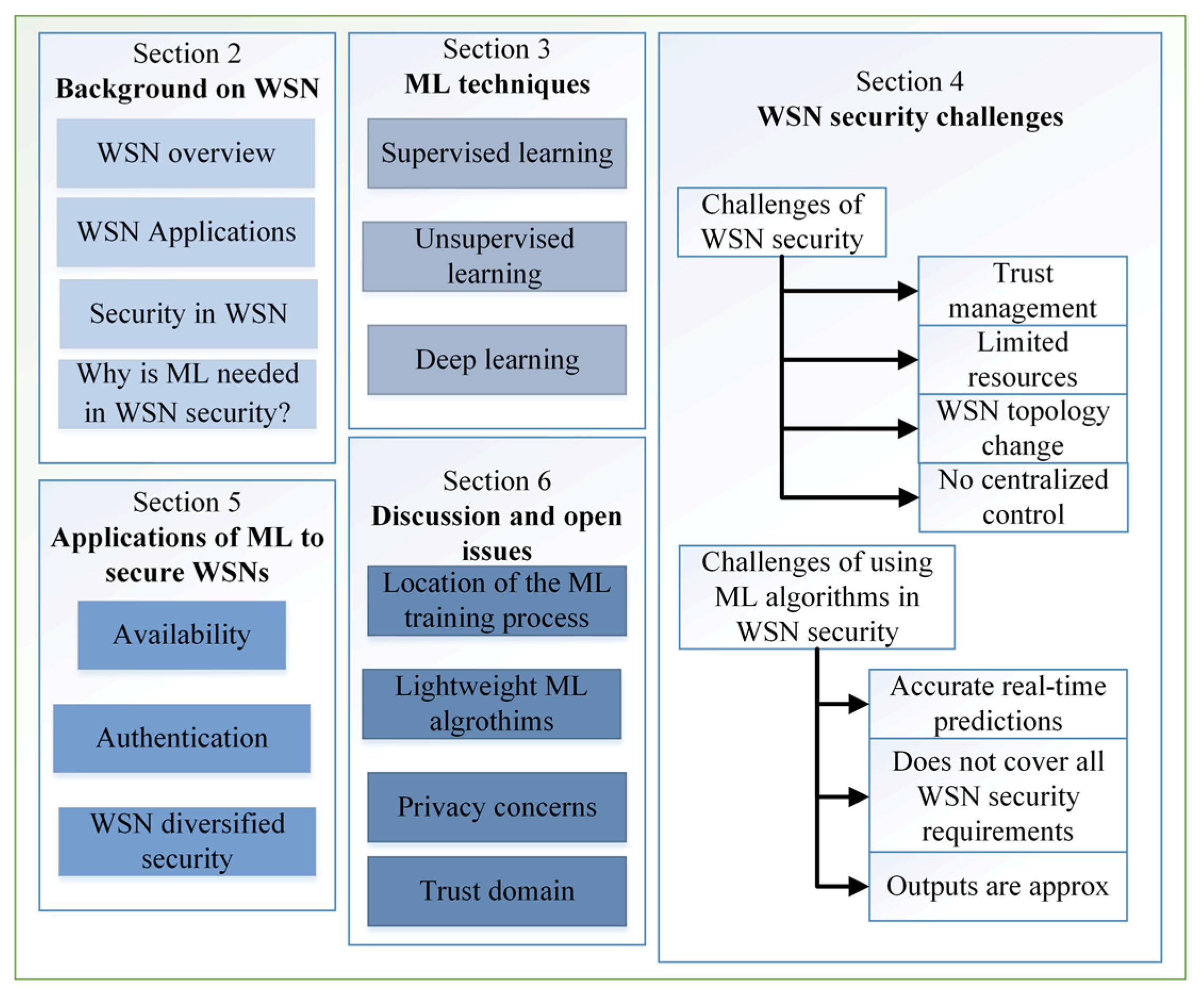
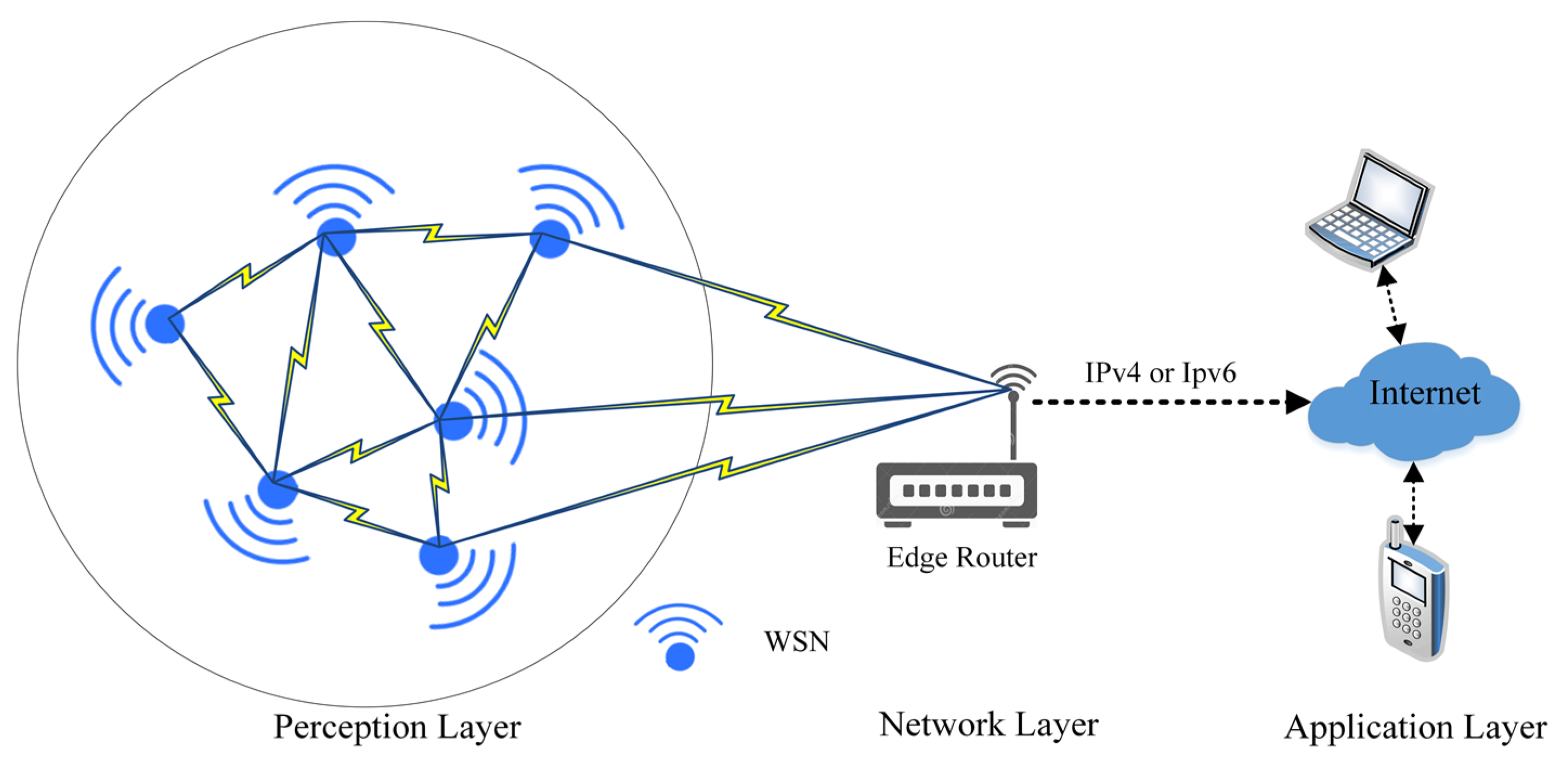
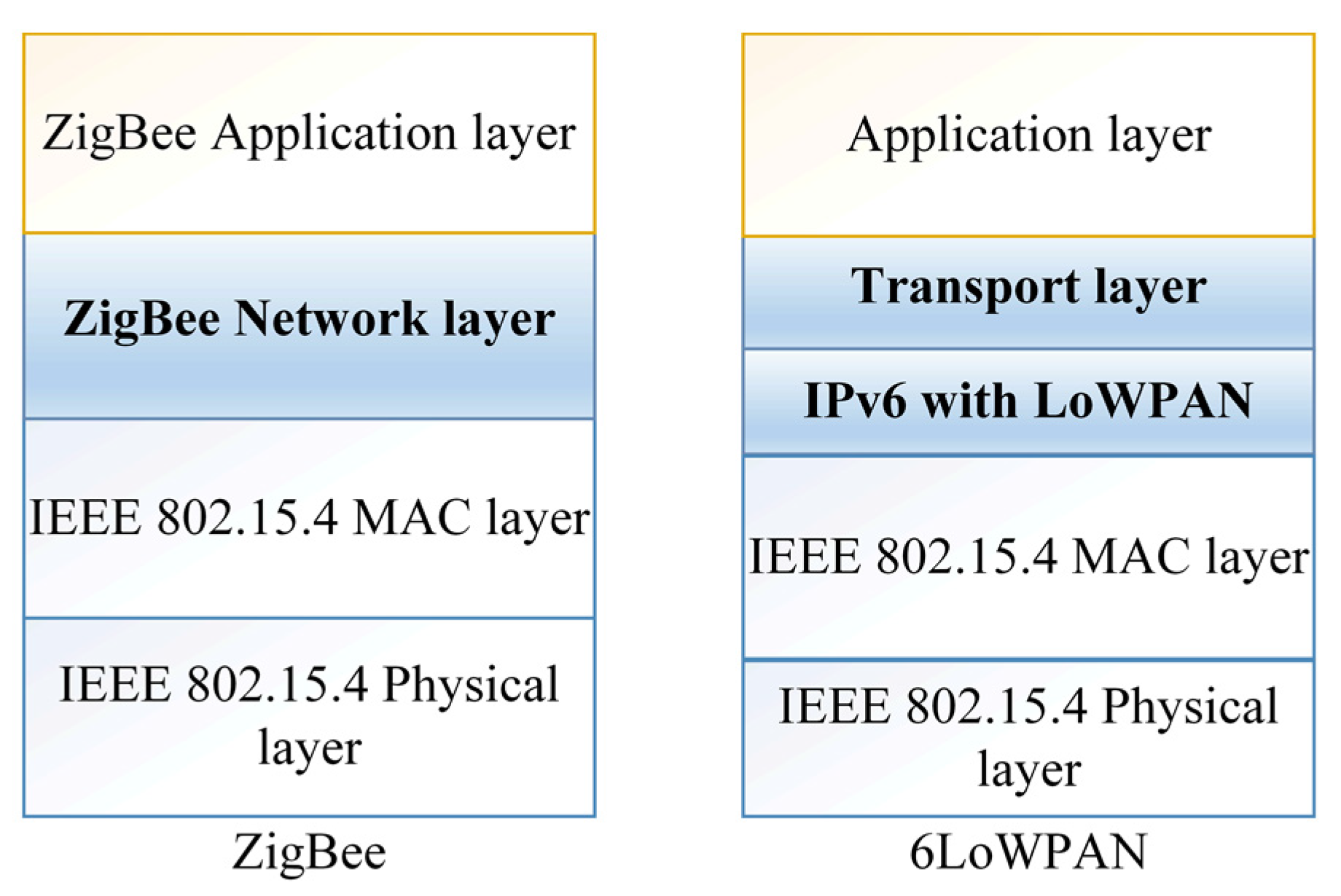
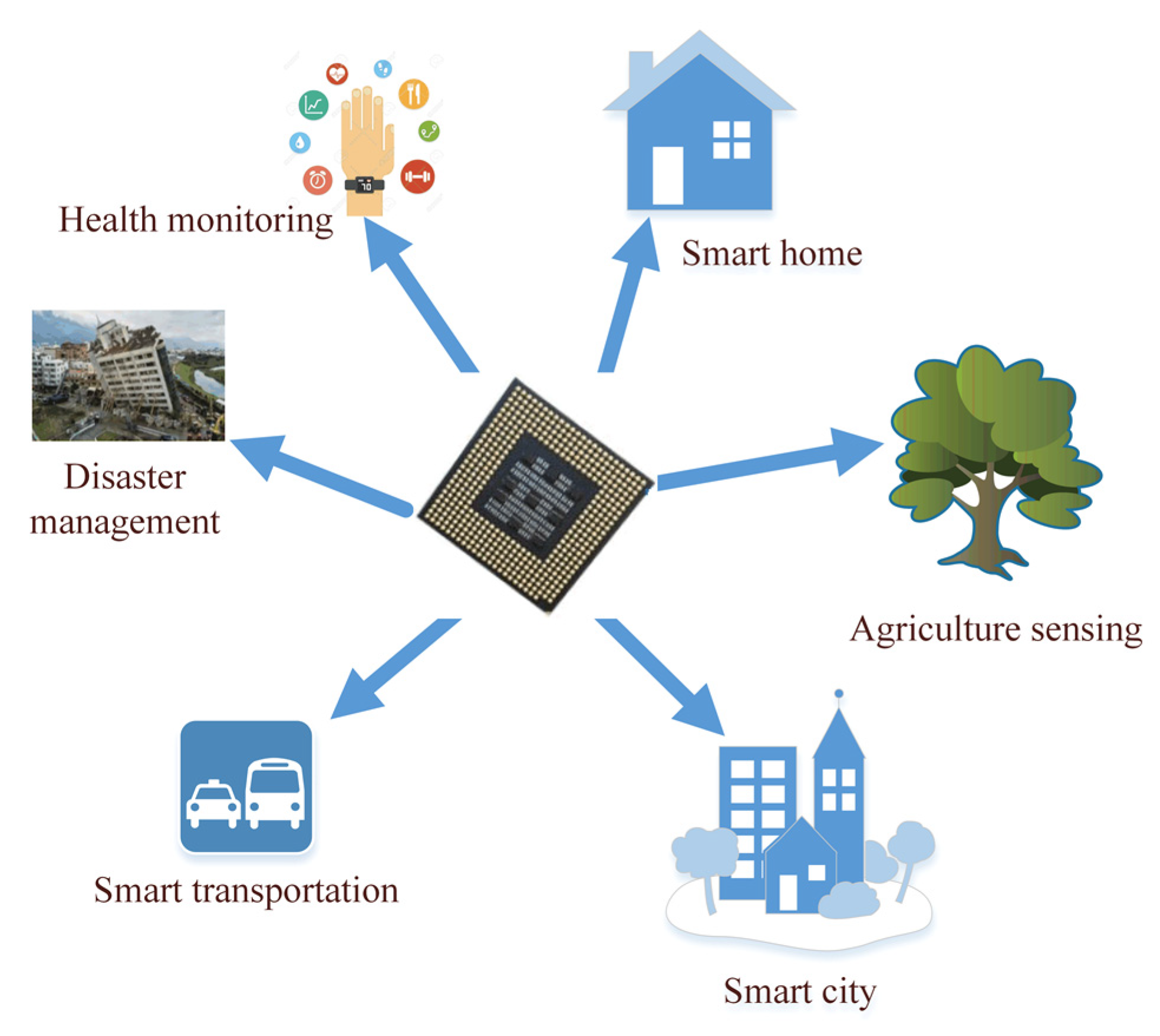
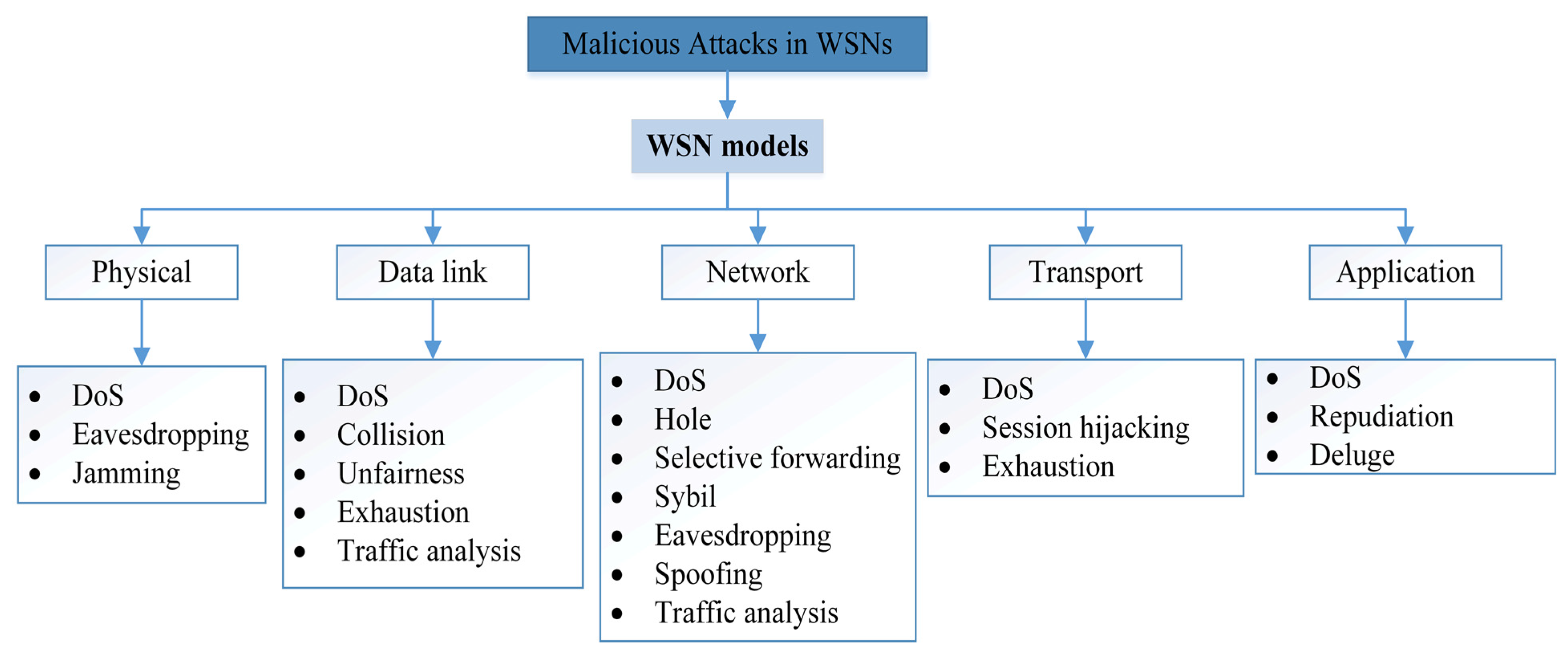

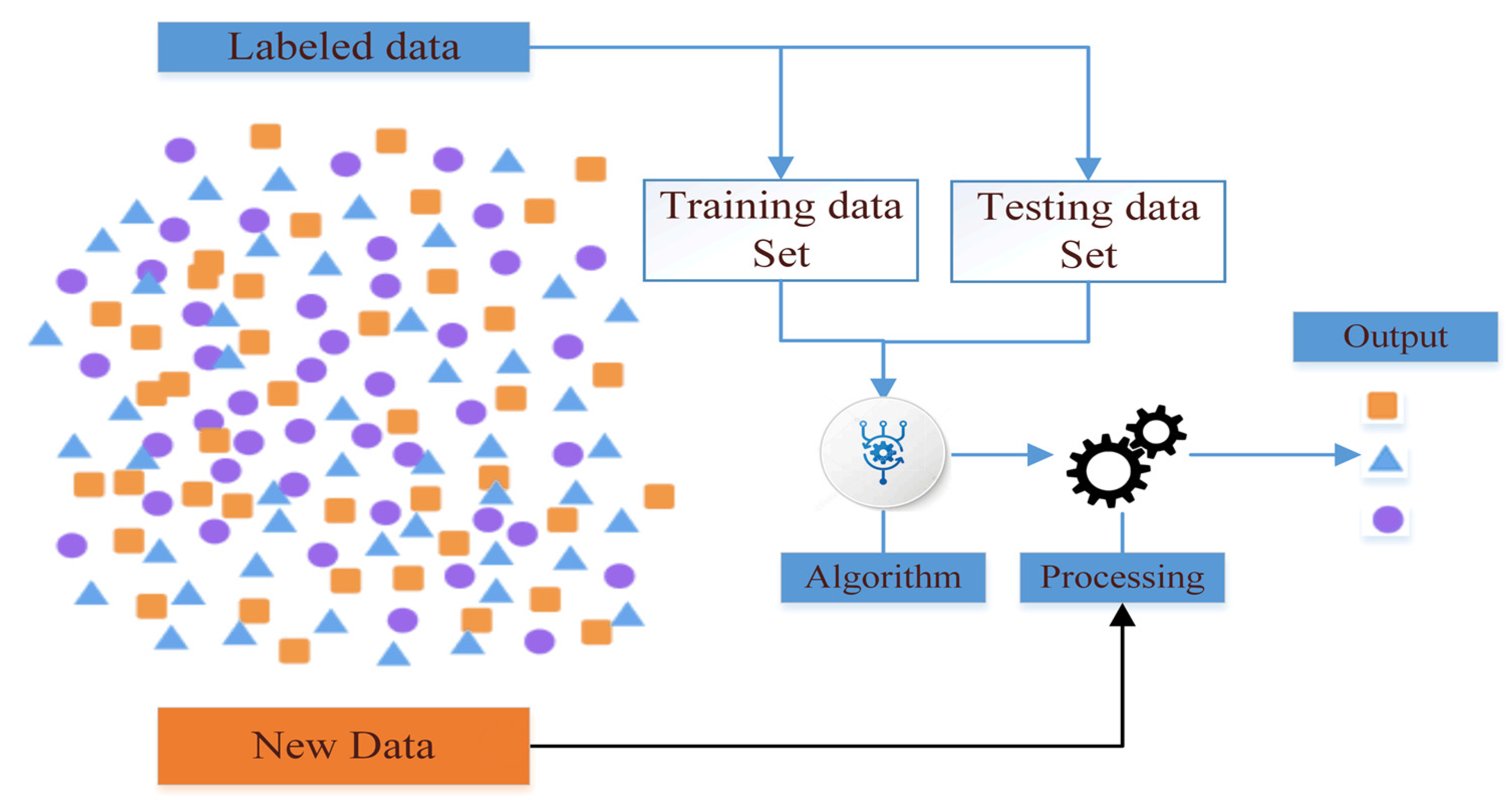

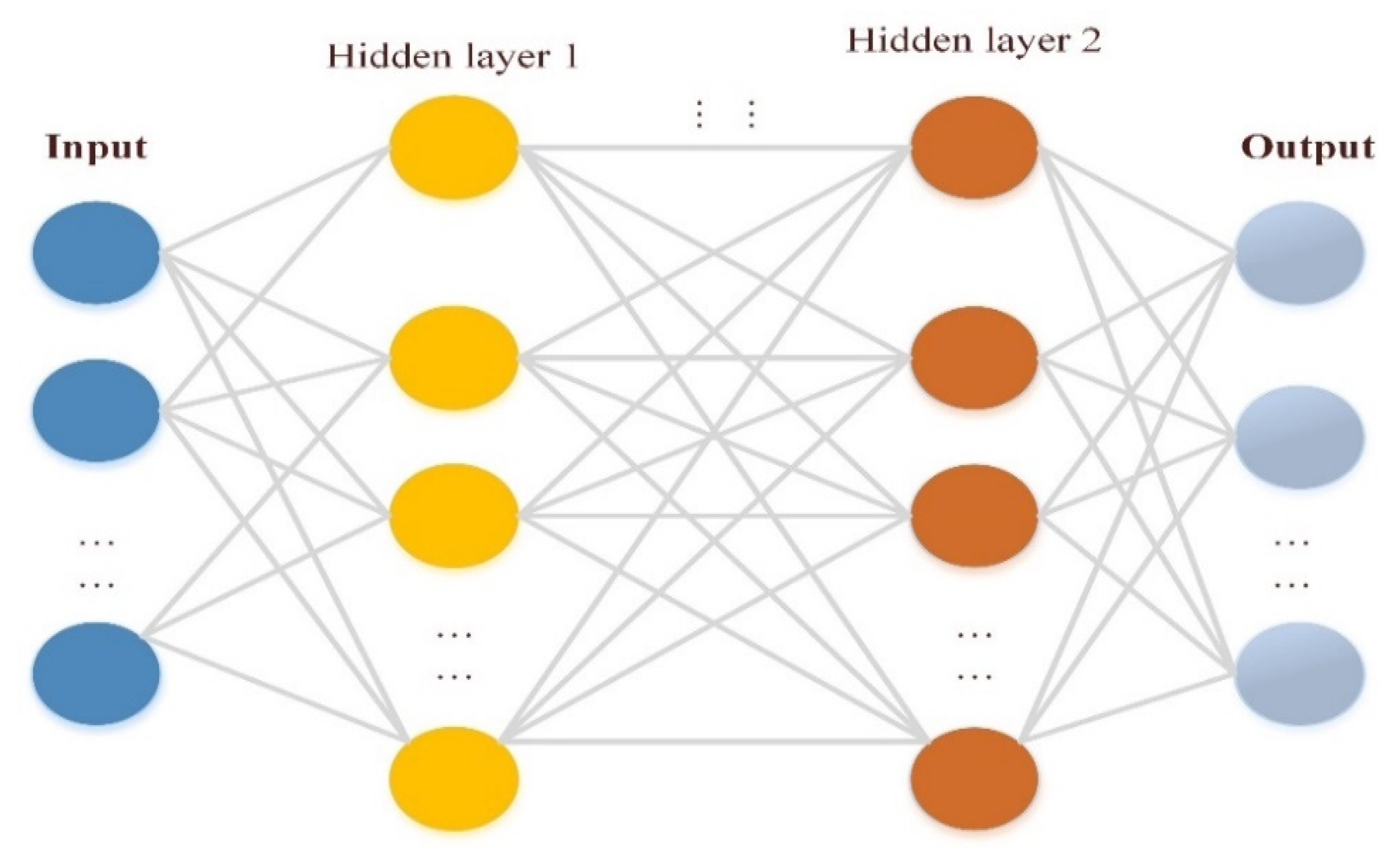

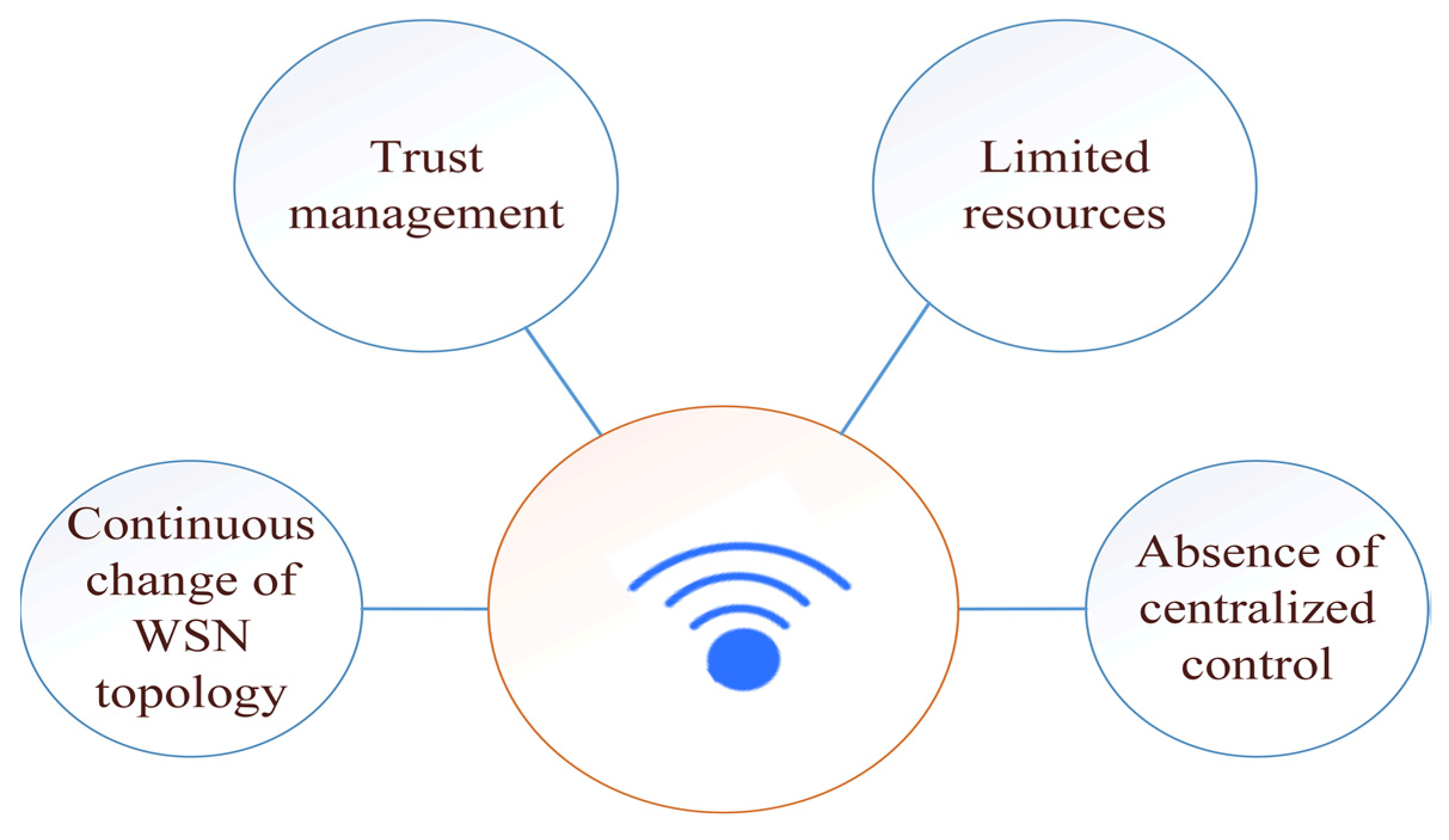

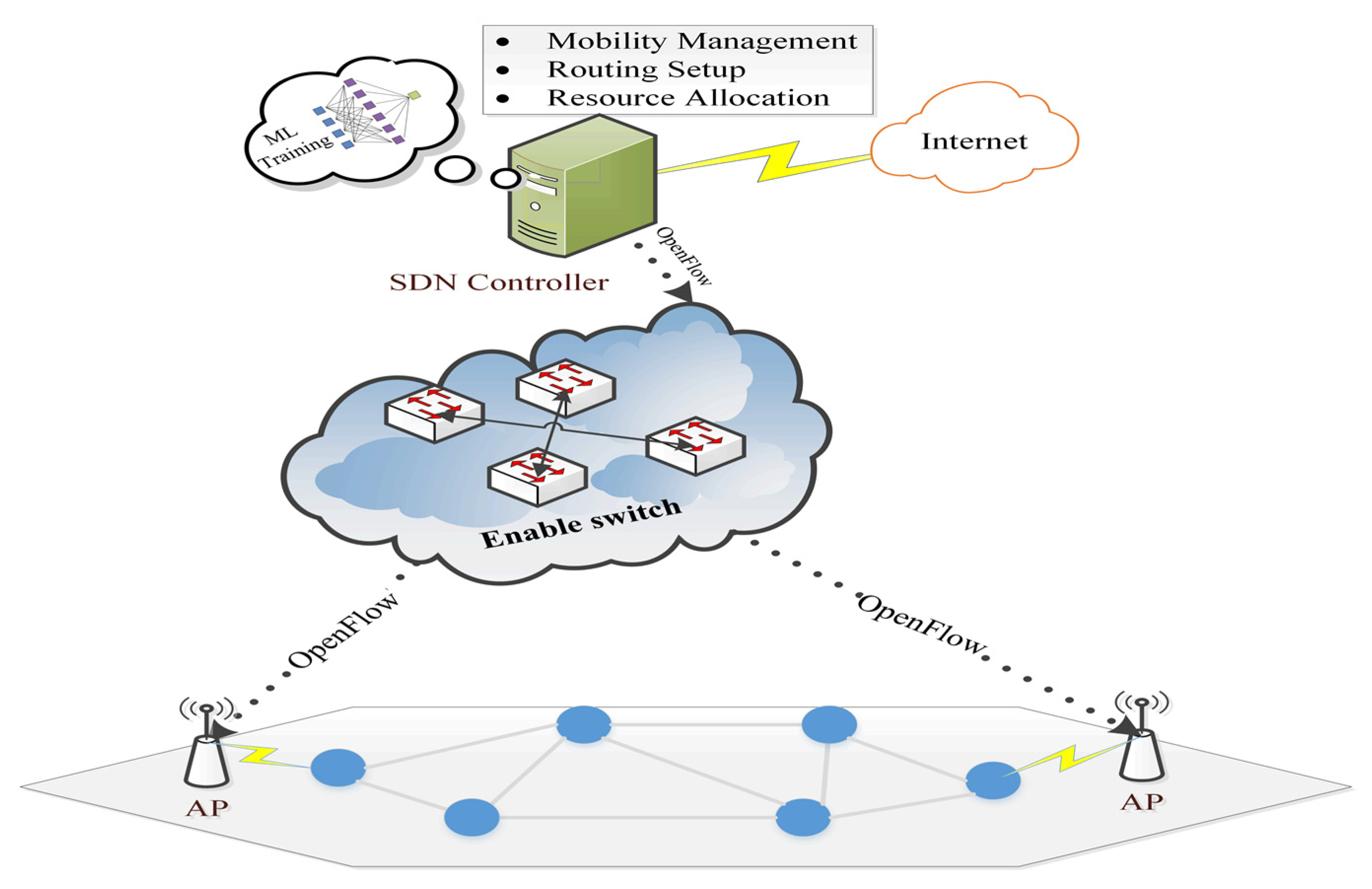
| Security Infrastructure | Attacks |
|---|---|
| Confidentiality | Hole, Sybil, Spoofing, Session hijacking, Repudiation, Selective forwarding, Spoofing |
| Integrity | Eavesdropping, traffic analysis, Selective forwarding, Spoofing |
| Availability | DoS, Exhaustion, Jamming, Collision, Unfairness |
| Security Infrastructure | Attacks |
|---|---|
| Confidentiality | Encryption |
| Integrity | Digital signature, MAC |
| Availability | Traffic control, redundancy, Rerouting |
| Non-repudiation | Digital certificate |
| No. | Challenges |
|---|---|
| 1. | Accurate real-time predictions |
| 2. | The use of ML does not cover all the security requirements of WSNs |
| 3. | Outputs are approx. |
| Refs. | ML Technique | Processing Cost | Error Detected | Accuracy | Limitations |
|---|---|---|---|---|---|
| [23] | SVM, KNN, and RNN | Relative | Offset, gain, stuck-at, and out of bounds | 97% | Calculating the reliability of the decision is complex |
| [128] | hidden Markov model + Neural networks (NNs) | high | Random, drift, and spike | 96% | Training speed is slow |
| [129] | SVM | Low | Negative alerts | 99% | Does not consider the load management between nodes |
| [130] | SVM | High | Fault WSN nodes | 98% | Not suitable for large networks |
| [131] | SVM + principal component analysis | High | Fault WSN nodes | 99% | complexity is high |
| [24] | Bayesian | High | Fault WSN nodes | 70% | Bayesian increases the complexity of the WSN devices |
| [25] | Bayesian | High | Fault WSN nodes | 100% | It takes more time to detect due to the use of two different detection systems |
| [132] | KNN | Moderate | Fault WSN nodes | 99% | Not cover continuous change in WSN topology |
| Refs. | ML Technique | Processing Cost | Control Policy | Detection Criteria |
|---|---|---|---|---|
| [17] | Fuzzy logic | Low | Queue management | Buffer occupancy |
| [133] | Fuzzy logic | moderate | Queue management | buffer occupancy |
| [18] | Fuzzy logic | High | Traffic control | Buffer occupancy |
| [19] | Heuristic and Fuzzy logic | High | Traffic control | Channel load |
| [134] | K-mean, Firefly, and ant colony | High | Traffic control | Packet service time |
| [135] | Fuzzy logic | Low | Traffic control | Buffer occupancy |
| Refs. | ML Technique | Processing Cost | Attack | Accuracy | Limitations |
|---|---|---|---|---|---|
| [146] | ANN | High | Man in the Middle | 99% | It needs huge data sets |
| [147] | Random Forest | Low | Traffic monitoring (identification) | 96% | Not expandable |
| [148] | Binary classifier | Low | Traffic monitoring (identification) | 95% | Centralization of classification |
| [26] | k-mean + SVM | Moderate | Malicious node | NA | Centralization of classification |
| [149] | Random forest | Low | Privacy | NA | Require large memory for storage |
| [74] | Random Forest + SVM | Moderate | Channel identification | NA | Not effective for large networks |
Publisher’s Note: MDPI stays neutral with regard to jurisdictional claims in published maps and institutional affiliations. |
© 2022 by the authors. Licensee MDPI, Basel, Switzerland. This article is an open access article distributed under the terms and conditions of the Creative Commons Attribution (CC BY) license (https://creativecommons.org/licenses/by/4.0/).
Share and Cite
Ahmad, R.; Wazirali, R.; Abu-Ain, T. Machine Learning for Wireless Sensor Networks Security: An Overview of Challenges and Issues. Sensors 2022, 22, 4730. https://doi.org/10.3390/s22134730
Ahmad R, Wazirali R, Abu-Ain T. Machine Learning for Wireless Sensor Networks Security: An Overview of Challenges and Issues. Sensors. 2022; 22(13):4730. https://doi.org/10.3390/s22134730
Chicago/Turabian StyleAhmad, Rami, Raniyah Wazirali, and Tarik Abu-Ain. 2022. "Machine Learning for Wireless Sensor Networks Security: An Overview of Challenges and Issues" Sensors 22, no. 13: 4730. https://doi.org/10.3390/s22134730
APA StyleAhmad, R., Wazirali, R., & Abu-Ain, T. (2022). Machine Learning for Wireless Sensor Networks Security: An Overview of Challenges and Issues. Sensors, 22(13), 4730. https://doi.org/10.3390/s22134730







